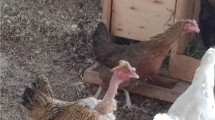Abstract
Variation in sexual dimorphism (SD) is particularly marked in meat-type chickens. This paper investigates the genetic basis of SD in an important economic trait, i.e. body weight (BW) at 35 days of age, in broilers by applying quantitative genetic analysis. A large dataset comprising 203,323 BW records of a commercial line of broiler chicken was used. First, a bivariate approach was employed treating BW as a sex-specific trait. During this approach, seven bivariate models were applied and variances due to direct additive genetic, maternal genetic and maternal environmental effects were estimated via the restricted maximum likelihood method. The best-fitting model included direct additive genetic, maternal genetic and maternal environmental effects with a direct–maternal genetic covariance. Differences between male and female direct heritabilities were non-significant (0.28 vs. 0.29 for males and females, respectively), implying no need for sex-specific selection strategies. The direct–maternal genetic correlation was more strongly negative in males than in females (−0.72 vs. −0.56), implying a more profound antagonism between direct additive and maternal genetic effects in this particular gender. The direct genetic correlation of BW between the two sexes was as high as 0.91, i.e. only slightly lower than unity. Second, variance components and genetic parameters of two measures of SD, i.e. the weight difference (Δ) and the weight ratio (R), between the genders were estimated. Direct heritabilities for both measures were significantly different to 0 but of low magnitude (0.04). Apart from the additive–maternal covariance, no other random effects were found to be of importance for Δ and R. The results of the present study suggest that only minimal selection responses due to the selection of Δ and/or R and a small capacity for amplifying or reducing the BW differences between the sexes are to be expected in this specific population. Furthermore, selection pressure on BW is expected to amplify SD.
Similar content being viewed by others
References
Aggrey SE, Cheng KM (1994) Animal model analysis of genetic (co)variances for growth traits in Japanese quail. Poult Sci 73:1822–1828
Akaike H (1973) Information theory and an extension of the maximum likelihood principle. In: Petrov BN, Csaki F (eds) Proceedings of the Second International Symposium on Information Theory, Budapest, Hungary, pp 267–281
Badyaev AV (2002) Male and female growth in sexually dimorphic species: harmony, conflict, or both? Comments Theor Biol 7:11–33
Blanckenhorn WU (2005) Behavioral causes and consequences of sexual size dimorphism. Ethology 111:977–1016
Chapuis H, Tixier-Boichard M, Delabrosse Y, Ducrocq V (1996) Multivariate restricted maximum likelihood estimation of genetic parameters for production traits in three selected turkey strains. Genet Sel Evol 28:197–215
Eisen EJ, Legates JE (1966) Genotype-sex interaction and the genetic correlation between the sexes for body weight in Mus musculus. Genetics 54:611–623
Falconer DS, Mackay TFC (1996) Introduction to quantitative genetics, 4th edn. Longman Group, Harlow, Essex, UK
Gilmour AR, Gogel BJ, Cullis BR, Thompson R (2009) ASReml user guide release 3.0. VSN International Ltd., Hemel Hempstead
Hanrahan JR, Eisen EJ (1973) Sexual dimorphism and direct and maternal genetic effects on body weight in mice. Theor Appl Genet 43:39–45
Ilska JJ, Kranis A, Burt DW, Wooliams J (2011) The variance composition of broiler traits estimated on a large commercial population. In: Proceedings of the 7th European Symposium on Poultry Genetics, Edinburgh, Scotland, October 2011
Kirkpatrick M, Lande R (1989) The evolution of maternal characters. Evolution 43:485–503
Koerhuis ANM, Thompson R (1997) Models to estimate maternal effects for juvenile body weight in broiler chickens. Genet Sel Evol 29:225–249
Lee C, Pollak EJ (1997) Relationship between sire × year interactions and direct–maternal genetic correlation for weaning weight of Simmental cattle. J Anim Sci 75:68–75
Lynch M, Walsh B (1998) Genetics and analysis of quantitative traits. Sinauer Associates, Sunderland
Maniatis N, Pollott GE (2003) The impact of data structure on genetic (co)variance components of early growth in sheep, estimated using an animal model with maternal effects. J Anim Sci 81:101–108
Mignon-Grasteau S, Beaumont C, Poivey J-P, de Rochambeau H (1998) Estimation of the genetic parameters of sexual dimorphism of body weight in ‘label’ chickens and Muscovy ducks. Genet Sel Evol 30:481–491
Räsänen K, Kruuk LEB (2007) Maternal effects and evolution at ecological time-scales. Funct Ecol 21:408–421
Rasch D (1987) Einführung in die Biostatistik, 2 Auflage. Verlag Harri Deutsch, Frankfurt/Main, s. 198
Remeš V, Székely T (2010) Domestic chickens defy Rensch’s rule: sexual size dimorphism in chicken breeds. J Evol Biol 23:2754–2759
Rensch B (1950) Die Abhängigkeit der relativen Sexualdifferenz von der Körpergröße. Bonn Zool Beitr 1:58–69
Robinson DL (1996) Models which might explain negative correlations between direct and maternal genetic effects. Livest Prod Sci 45:111–122
Roff DA (2002) Life history evolution. Sinauer, Sunderland
SAS Inc. (2009) SAS/STAT 9.2 User’s Guide. SAS Inc., Cary, NC, USA
Schwarz G (1978) Estimating the dimension of a model. Ann Stat 6:461–464
Stone M (1977) An asymptotic equivalence of choice of model by cross-validation and Akaike’s criterion. J Roy Stat Soc B 39(1):44–47
Sutherland TM (1965) The correlation between feed efficiency and rate of gain, a ratio and its denominator. Biometrics 21:739–749
Willham RL (1972) The role of maternal effects in animal breeding. 3. Biometrical aspects of maternal effects in animals. J Anim Sci 35:1288–1293
Wilson AJ, Reale D (2006) Ontogeny of additive and maternal genetic effects: lessons from domestic mammals. Am Nat 167:E23–E38
Author information
Authors and Affiliations
Corresponding author
Rights and permissions
About this article
Cite this article
Maniatis, G., Demiris, N., Kranis, A. et al. Genetic analysis of sexual dimorphism of body weight in broilers. J Appl Genetics 54, 61–70 (2013). https://doi.org/10.1007/s13353-012-0116-y
Received:
Revised:
Accepted:
Published:
Issue Date:
DOI: https://doi.org/10.1007/s13353-012-0116-y




